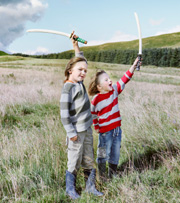A short article by Howard Chudacoff, author of Children at Play: An American History (NYU Press 2008)
 This year, surveys are showing that 36 percent of American families expect to spend less on holiday purchases than in 2007, and toy manufacturers and retailers expect sales declines. Does this mean that American kids are going to be deprived? Is the recession that began in late 2008 going to alter the ways that children play?
This year, surveys are showing that 36 percent of American families expect to spend less on holiday purchases than in 2007, and toy manufacturers and retailers expect sales declines. Does this mean that American kids are going to be deprived? Is the recession that began in late 2008 going to alter the ways that children play?
Today, play connotes doing something with commercial toys. This has not always been the case. Through most of American history, children have amused themselves with playthings that often were devised from household objects or from nature. Anything could be a plaything, and what was a plaything at one time may not be so at another. A tree branch could be a horse, a musket, an imaginary friend. Girls fashioned dolls from corn husks, and boys used logs for sleds. Yes, there were kites, tops, balls, marbles, and puzzles, but diaries and memoirs from the eighteenth and nineteenth centuries consistently show that manufactured toys took second place to playthings and activities that originated from a child’s resourcefulness.
Children’s play in the early days may not have been parent-approved. New Englander Emily Wilson, growing up in the 1840s, recalled this childhood delight: “Our kitchen boasted a cook stove, the like of which I have never seen elsewhere. It had a rotary top turned by a crank at the side. . . . [My sister and I] very soon recognized the possibility of using it for our amusement and one, seated on the top, rode round and round while the other operated the crank.” Future reformer Lincoln Steffens, who spent his boyhood in California, disturbed household order when he imagined himself as “a teamster. . . . I remember having a leaf from our dining-room table on the floor, kneeling on it, and taking a hold of one end, jerking it backward over the carpet, tooting like a steam boat whistle. Three or four big chairs and all the small chairs in the house made me a mountain train of wagons and mules, a clothes line tied to the leader and strung through the other chairs was a rein which I could jerk as the black-bearded teamster did.” Mostly, however, kids harmlessly improvised. As humorist Sam Levenson recalled from his 1920s boyhood, “Ashcan covers were converted into Roman shields, oatmeal boxes into telephones, combs covered with tissue paper into kazoos, . . . hatboxes into drums, clothespins into pistols, and lumps of sugar into dice.” These kids did not need Elmo, Transformers, or Barbie, not to mention ipods and X-boxes.
Things are different today. Toymakers and the media exert powerful influence over children’s play, and kids respond by expressing their wants in forceful ways. Toys are safer, more sophisticated, and more colorful. And to keep children amused and out of the way, parents expand youngsters’ playthings by buying more and more toys while limiting their play by directing them into adult-controlled playsites. Perhaps many families will buy some less expensive play items this Christmas season, but it is unlikely that kids will be deprived of formal things to play with. The question is: Will children have the same opportunities to exercise their imaginations in the ways that Emily Wilson and Lincoln Steffens did?
